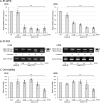An antisense amido-bridged nucleic acid gapmer oligonucleotide targeting SRRM4 alters REST splicing and exhibits anti-tumor effects in small cell lung cancer and prostate cancer cells
- PMID: 36650528
- PMCID: PMC9847160
- DOI: 10.1186/s12935-022-02842-1
An antisense amido-bridged nucleic acid gapmer oligonucleotide targeting SRRM4 alters REST splicing and exhibits anti-tumor effects in small cell lung cancer and prostate cancer cells
Abstract
Background: Antisense oligonucleotide (ASO) medicine for clinical applications has been becoming a reality. We previously developed a gapmer ASO targeting Ser/Arg repetitive matrix 4 (SRRM4) that is abnormally expressed in small cell lung cancer (SCLC). However the detailed mechanism of ASO through repressing SRRM4 has not been completely elucidated. Further, effectiveness of SRRM4 ASO to prostate cancer (PCa) cells expressing SRRM4 similar to SCLC remains to be elucidated. RE1-silencing transcription factor (REST) is a tumor suppressor, and its splicing isoform (sREST) is abnormally expressed by SRRM4 and causes carcinogenesis with neuroendocrine phenotype in SCLC. The present study aimed to understand the contribution of REST splicing by SRRM4 ASO administration.
Methods: SRRM4 expression and REST splicing were analyzed by RT-qPCR and conventional RT-PCR after treating SRRM4 ASO, and cell viability was analyzed in vitro. Exogenous reconstitution of Flag-tagged REST plasmid in SCLC cells and the splice-switching oligonucleotide (SSO) specific for REST was analyzed for cell viability. Furthermore, we expanded the application of SRRM4 ASO in PCa cells abnormally expressing SRRM4 mRNA in vitro.
Results: SRRM4 ASO successfully downregulated SRRM4 expression, followed by repressed cell viability of SCLC and PCa cells in a dose-dependent manner. Administration of SRRM4 ASO then modified the alternative splicing of REST, resulting reduced cell viability. REST SSO specifically modified REST splicing increased REST expression, resulting in reduced cell viability.
Conclusions: Our data demonstrate that a gapmer ASO targeting SRRM4 (SRRM4 ASO) reduces cell viability through splicing changes of REST, followed by affecting REST-controlled genes in recalcitrant tumors SCLC and PCa cells.
Keywords: Antisense oligonucleotide; Gapmer; Prostate cancer; REST/NRSF; SCLC; SRRM4; Small cell lung cancer.
© 2023. The Author(s).
Conflict of interest statement
The authors declare that they have no competing interests.
Figures




Similar articles
-
Splice-switching antisense oligonucleotide controlling tumor suppressor REST is a novel therapeutic medicine for neuroendocrine cancer.Mol Ther Nucleic Acids. 2024 Jul 2;35(3):102250. doi: 10.1016/j.omtn.2024.102250. eCollection 2024 Sep 10. Mol Ther Nucleic Acids. 2024. PMID: 39377066 Free PMC article.
-
A gapmer antisense oligonucleotide targeting SRRM4 is a novel therapeutic medicine for lung cancer.Sci Rep. 2019 May 20;9(1):7618. doi: 10.1038/s41598-019-43100-1. Sci Rep. 2019. PMID: 31110284 Free PMC article.
-
The small cell lung cancer-specific isoform of RE1-silencing transcription factor (REST) is regulated by neural-specific Ser/Arg repeat-related protein of 100 kDa (nSR100).Mol Cancer Res. 2013 Oct;11(10):1258-68. doi: 10.1158/1541-7786.MCR-13-0269. Epub 2013 Aug 8. Mol Cancer Res. 2013. PMID: 23928058
-
[Recent progress and prospect in oligonucleotide therapeutics].Nihon Rinsho. 2015 Jun;73(6):1057-65. Nihon Rinsho. 2015. PMID: 26065142 Review. Japanese.
-
Antisense oligonucleotides: from design to therapeutic application.Clin Exp Pharmacol Physiol. 2006 May-Jun;33(5-6):533-40. doi: 10.1111/j.1440-1681.2006.04403.x. Clin Exp Pharmacol Physiol. 2006. PMID: 16700890 Review.
Cited by
-
A novel transient receptor potential C3/C6 selective activator induces the cellular uptake of antisense oligonucleotides.Nucleic Acids Res. 2024 May 22;52(9):4784-4798. doi: 10.1093/nar/gkae245. Nucleic Acids Res. 2024. PMID: 38621757 Free PMC article.
-
Targeting Key Players of Neuroendocrine Differentiation in Prostate Cancer.Int J Mol Sci. 2023 Sep 5;24(18):13673. doi: 10.3390/ijms241813673. Int J Mol Sci. 2023. PMID: 37761978 Free PMC article. Review.
-
Nucleic acid-based therapeutics for the treatment of central nervous system disorders.Front Genet. 2023 Aug 16;14:1250276. doi: 10.3389/fgene.2023.1250276. eCollection 2023. Front Genet. 2023. PMID: 37662844 Free PMC article. Review.
-
Alternative splicing in prostate cancer progression and therapeutic resistance.Oncogene. 2024 May;43(22):1655-1668. doi: 10.1038/s41388-024-03036-x. Epub 2024 Apr 24. Oncogene. 2024. PMID: 38658776 Free PMC article. Review.
-
Multi-center study: ultrasound-based deep learning features for predicting Ki-67 expression in breast cancer.Sci Rep. 2025 Mar 25;15(1):10279. doi: 10.1038/s41598-025-94741-4. Sci Rep. 2025. PMID: 40133523 Free PMC article.
References
-
- Setoguchi K, Cui L, Hachisuka N, Obchoei S, Shinkai K, Hyodo F, Kato K, Wada F, Yamamoto T, Harada-Shiba M, et al. Antisense oligonucleotides targeting Y-Box binding protein-1 inhibit tumor angiogenesis by downregulating Bcl-xL-VEGFR2/-Tie axes. Mol Ther Nucleic Acids. 2017;9:170–181. doi: 10.1016/j.omtn.2017.09.004. - DOI - PMC - PubMed
Grants and funding
LinkOut - more resources
Full Text Sources

